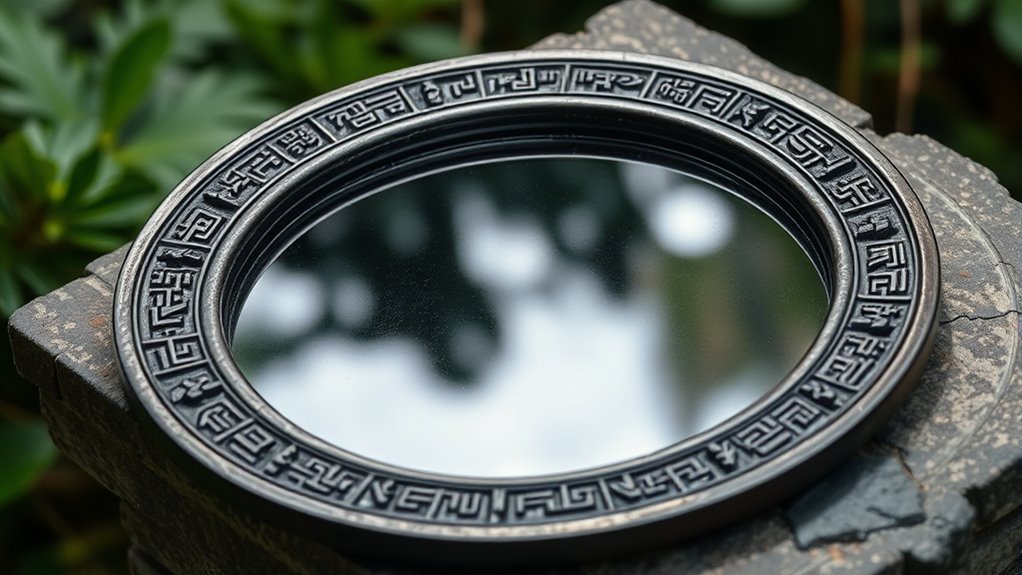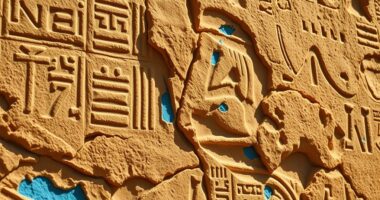Ancient Mayans used polished hematite mirrors as sacred tools to observe celestial events, especially eclipses. You’d position these mirrors at specific angles to reflect the sun or moon during an eclipse, helping them predict such events with remarkable accuracy. These mirrors weren’t just reflective surfaces but spiritual instruments linking sky phenomena with divine messages. If you want to discover how this ancient technology played a essential role in Mayan astronomy and rituals, keep exploring their fascinating practices.
Key Takeaways
- Mayans polished hematite mirrors to create reflective surfaces used in celestial observations.
- They positioned mirrors at specific angles to reflect sunlight or moonlight during eclipses.
- The mirrors helped observe light patterns and changes associated with solar or lunar eclipses.
- Eclipses were interpreted as divine messages, guiding ceremonial and societal decisions.
- The precise use of mirrors demonstrated advanced Mayan knowledge of astronomy and celestial phenomena.

Ancient Mayans crafted hematite mirrors that reveal more than just your reflection; these polished stones held deep spiritual and ceremonial significance. When you look into these mirrors, you’re not only seeing your image but also connecting with a tradition rooted in sophisticated mirror craftsmanship. The Mayans believed these reflective surfaces could channel celestial energies, making them essential tools in understanding and predicting astronomical events. The gleam of hematite, a naturally occurring mineral, was carefully polished to achieve a mirror-like finish, demonstrating their skill and precision. This mirror craftsmanship wasn’t just about beauty; it served a sacred purpose, especially in observing the cosmos. Their knowledge of weight of wind turbine blades and how it impacts energy collection illustrates their advanced understanding of natural phenomena, which may have influenced their astronomical observations.
Ancient Mayan hematite mirrors combined craftsmanship, spirituality, and astronomy to connect with celestial energies and observe cosmic events.
The Mayans associated celestial events with profound spiritual meaning, and eclipses were no exception. Their understanding of eclipse symbolism extended beyond mere natural phenomena; they saw eclipses as cosmic battles or messages from the gods. Harnessing hematite mirrors, they developed methods to observe and interpret these sky events. When an eclipse approached, they would hold these mirrors at specific angles, reflecting the sun or moon and allowing them to study the changing light patterns. This act wasn’t casual; it was a deliberate ritual that intertwined astronomy with spiritual practice. The way the light interacted with the polished hematite surface provided clues about the eclipse’s progression, duration, and significance.
Using these mirrors, the Mayans could predict eclipses with remarkable accuracy for their time. They recognized subtle changes in light and shadow that signaled the approach of celestial alignments. This knowledge wasn’t just for practical purposes but also deeply embedded into their religious calendar, where eclipses often signified divine messages or portents. The careful observation of eclipse symbolism through hematite mirrors helped them prepare for important ceremonies, wars, or agricultural activities, aligning their lives with cosmic rhythms.
In essence, these mirrors were more than reflective objects; they were sophisticated instruments blending art, science, and spirituality. The mastery of mirror craftsmanship allowed the Mayans to harness celestial phenomena, turning an ordinary mineral into a conduit for divine understanding. When you consider their ability to predict eclipses so accurately, it’s clear that their use of hematite mirrors was a tribute to their advanced astronomical knowledge and deep spiritual connection to the cosmos. This unique fusion of craftsmanship and symbolism elevated the simple act of reflection into a sacred practice that bridged heaven and earth.
Frequently Asked Questions
How Accurate Were Mayan Eclipse Predictions Using Hematite Mirrors?
You wonder about the accuracy estimates of Mayan eclipse predictions using hematite mirrors. While their observational methods were sophisticated, they likely had limited precision compared to modern science. The Mayans relied on detailed astronomical records, but environmental factors and observational limitations probably affected their accuracy. Still, their ability to anticipate eclipses demonstrates impressive observational skill, though exact prediction accuracy remains uncertain due to the lack of detailed records.
Did Mayans Use Other Materials Besides Hematite for Eclipse Prediction?
You might be surprised to learn that the Mayans also used alternative materials like obsidian and shell for eclipse predictions, highlighting their resourcefulness. These materials held cultural significance, symbolizing spiritual power and divine insight. The Mayans believed these tools connected them to cosmic forces, enhancing their understanding of celestial events. Their use of diverse materials reflects a deep respect for nature and a sophisticated approach to astronomy that went beyond just hematite mirrors.
Were Hematite Mirrors Used Exclusively by Priests or the General Population?
You might wonder if hematite mirrors were only for priests or accessible to everyone. In Mayan ritual practices, these mirrors held sacred significance, often reserved for priests and elite figures who understood their spiritual and predictive roles. The general population likely had limited access, emphasizing their social exclusivity. This division highlights how ritual objects like hematite mirrors reinforced social hierarchies, making them crucial yet restricted tools within Mayan society.
How Did Mayans Interpret Celestial Events Beyond Eclipses?
You might think the Mayans only watched eclipses, but they also explored celestial symbolism through Mayan astrology. They interpreted planets, stars, and cosmic movements as divine messages, believing these events foretold seasons, wars, or societal shifts. These interpretations weren’t random; they followed a sophisticated system that connected celestial phenomena with their gods and destiny, showing a deep, almost poetic understanding of the universe’s hidden meanings beyond just eclipses.
Are There Any Existing Mayan Artifacts With Clear Evidence of Mirror Use?
You’ll find that archaeological artifacts showcasing mirror craftsmanship are rare but intriguing. Some ancient Mayan artifacts, like polished stones or reflective objects, suggest they used mirrors, possibly crafted from hematite or other materials. These artifacts hint at their sophisticated craftsmanship and potential use in rituals or astronomical observations. While direct evidence of mirrors specifically used for eclipse prediction remains elusive, these artifacts provide valuable insights into their technological and cultural practices.
Conclusion
You can appreciate how the Mayans’ use of hematite mirrors, which were believed to reflect celestial events, showcases their advanced astronomical knowledge. Remarkably, recent studies suggest that Mayan astronomers accurately predicted solar eclipses up to 30 years in advance, highlighting their impressive observational skills. This ancient practice not only reveals their sophisticated understanding of celestial cycles but also underscores their ingenuity in using simple tools like mirrors to reveal cosmic secrets.









